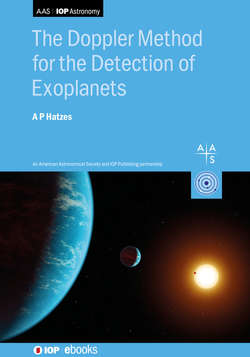Читать книгу The Doppler Method for the Detection of Exoplanets - Professor Artie Hatzes - Страница 14
На сайте Литреса книга снята с продажи.
1.5 The 51 Peg Revolution
ОглавлениеThe discovery of 51 Peg b (Mayor & Queloz 1995) clearly marked an explosion of the field3. This giant planet (M ≈ 0.5 MJup) in a 4.2 day orbit shocked astronomers, except maybe for the ghost of Otto Struve. It also demonstrated that RV surveys were probing the wrong parameter space (orbital distances of 5 au rather than 0.05 au)—the dangers of planning surveys based on one example, our solar system. The RV amplitude of ≈50 m s−1 (Figure 1.7) clearly benefited from the increased precision of Doppler measurements. Figure 1.8 shows the discovery rate of exoplanets found using the Doppler method. The sharp increase after the discovery of 51 Peg is for three reasons. First, once astronomers realized that giant planets could occur in short period orbits, they changed their observing strategies so that these short-period planets could be discovered rather quickly. Second, using the Doppler method to detect exoplanets became quite fashionable, with many groups “jumping on the bandwagon.” Prior to 1995, there were only a handful of groups using precise stellar RVs to search for exoplanets. Now, the number of such groups is in the dozens. Currently, approximately a hundred exoplanets per year are discovered with the Doppler method. Note that RV measurements also play a key role in the confirmation and mass determination of discoveries made by the transit method.
Figure 1.7. The discovery of 51 Peg b. The RV variations have an amplitude of ≈50 m s−1 and are phased to the orbital period of 4.2 days. The typical measurement error is ≈15 m s−1. (Adapted by permission from Macmillan Publishers Ltd: Mayor & Queloz 1995.)
Figure 1.8. The rate of exoplanet discovered planets using the Doppler method (transit discoveries are not included; data from http://www.exoplanet.eu).
Finally, the increased detection rate of exoplanets using Doppler measurement also benefited from the dramatic increase in RV precision over the past 30 years. The top panel of Figure 1.9 shows precise RV measurements of γ Cep (Walker et al. 1992). These show a scatter of about 15 m s−1—the measurement error they could achieve in the mid-1980s. The lower panel shows modern RV measurements of Proxima Centauri showing the variations of the Earth-mass companion in an 11.8 day orbit (Anglada-Escudé et al. 2016). These have a scatter of a mere 1 m s−1. Note that the scale of the y-axis in this lower panel is the size of the error bar in the top panel. An important aspect of this book is to show how this dramatic increase was achieved.
Figure 1.9. (Top) RV measurements of γ Cep phased to the orbital motion using Doppler measurements taken in the mid-1980s. (Bottom) RV measurements of Proxima Centauri phased to the orbital motion as measured in 2016. The box size for this panel is the same as the measurement error for the earlier measurements.
The parameter space in the mass versus semimajor axis of exoplanets discovered with the Doppler method is shown in Figure 1.10. These are only planets discovered through RV measurements and not those from transit discoveries, although Doppler measurements were important for confirming the nature of these discoveries and measuring the companion mass.
Figure 1.10. The detection parameter space for planets found using the Doppler method. This does not include transit discoveries. The method only measures the mass multiplied by the sine of the orbital inclination, i (M sin i).
